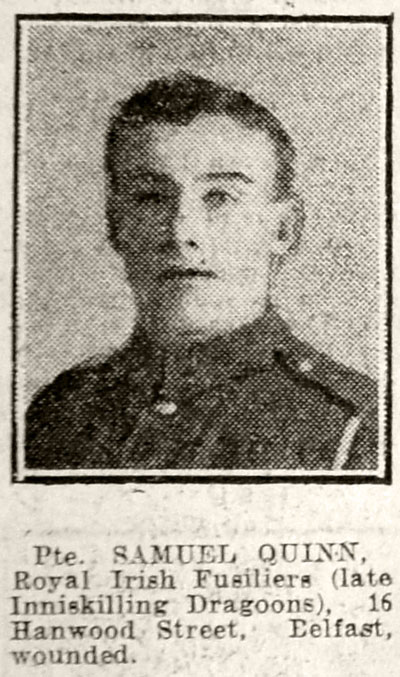Private Samuel Quinn
Samuel Quinn was born on 29 December 1889 at 30 Cultra Street, Belfast, the first of eleven children of carter (later labourer) William James Quinn and his wife Mary (née Megaw). The family moved to Scotland around 1896, returning to Belfast about ten years later. At the time of the 1911 Census Samuel was living at 16 Hanwood Street, Belfast, with his parents, his three surviving siblings, and another relative.
Quinn enlisted in the 6th (Inniskilling) Dragoons Service Squadron on 28 October 1914 (No. UD/68). On 6 October 1915 he embarked for France with his squadron, which was then serving as divisional cavalry to the 36th (Ulster) Division.
In June 1916 the Inniskilling squadron joined with C and F Squadrons of the North Irish Horse to form the 2nd North Irish Horse Regiment, serving as corps cavalry to X Corps. In August-September 1917 the Regiment was disbanded and its men, following training at the 36th (Ulster) Division Infantry Base Depot at Harfleur, were transferred to the Royal Irish Fusiliers, an infantry regiment. Most, including Quinn, were transferred on 20 September and posted to the 9th (Service) Battalion – renamed the 9th (North Irish Horse) Battalion – joining it in the field at Ruyaulcourt. Quinn was issued regimental number 41142.
He probably saw action with the battalion at the Battle of Cambrai in November and December 1917.
Quinn was wounded in the right forearm between 21 and 28 March 1918 during the 9th (NIH) Battalion's fighting withdrawal from St Quentin in the German spring offensive. Evacuated to the UK for treatment, on 8 October 1918 he was discharged from the army, being 'no longer physically fit for war service' (paragraph 392(xvi), King's Regulations).
Image from the Larne Times of 18 May 1918 kindly provided by Nigel Henderson, Researcher at History Hub Ulster.
This page last updated 17 February 2023.

